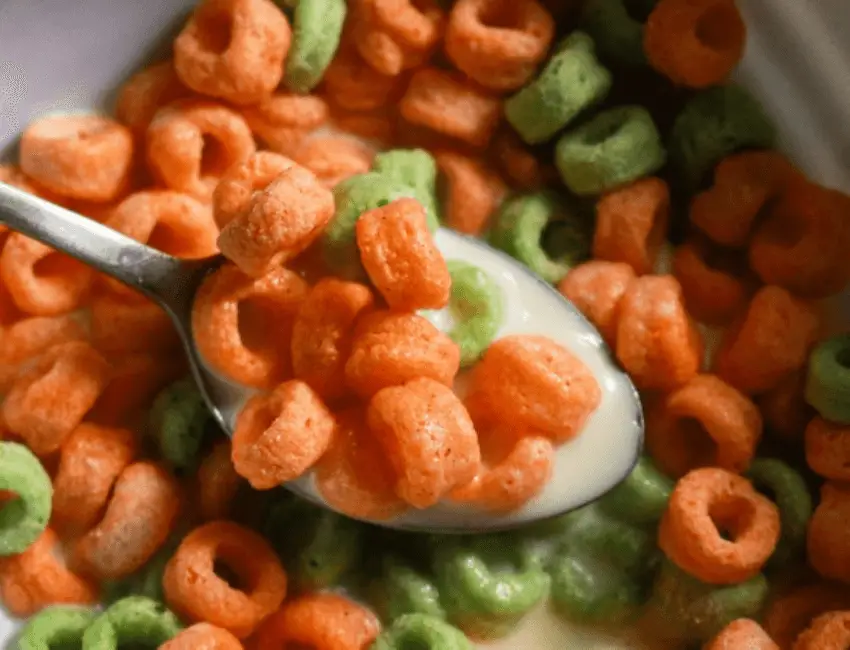As consumers become increasingly concerned about the ingredients and additives in the food they consume, questions about the contents of popular products such as Apple Jacks cereal have become more common. One question that has arisen is whether or not Apple Jacks cereal contains red dye.
This article will inform you of the ingredients in Apple Jacks cereal with a focus on any dyes used, including red dye. Let’s get into the details of what is in this classic cereal.
Original Apple Jacks & Red Dye
Yes, Original Apple Jacks have red dye and other dyes as well. The dyes help produce the fun but unnatural orange and green colors of the cereal loops.
By reviewing the ingredients list of Apple Jacks, it becomes evident whether or not the cereal contains dyes. As per the regulations set forth by the U.S. Food and Drug Administration (FDA), the manufacturer is required to disclose all the ingredients used in their product, including any dyes.
The ingredients of Apple Jacks at the time of this article are found below. We underlined all the dyes used which include red, yellow, and blue synthetic dyes. While the dyes are unnecessary, they help make the cereal more appealing and appetizing to consumers.
Original Apple Jacks Ingredients: Corn Flour Blend (Whole Grain Yellow Corn Flour, Degerminated Yellow Corn Flour), Sugar, Wheat Flour, Whole Grain Oat Flour, Modified Food Starch, Contains 2% Or Less Of Vegetable Oil (Hydrogenated Coconut, Soybean And/or Cottonseed), Oat Fiber, Salt, Soluble Corn Fiber, Degerminated Yellow Corn Flour, Dried Apples, Apple Juice Concentrate, Cornstarch, Cinnamon, Natural Flavor, Modified Corn Starch, Yellow 6, Wheat Starch, Baking Soda, Yellow 5, Red 40, Blue 1. Vitamins And Minerals: Reduced Iron, Niacinamide, Vitamin B6 (Pyridoxine Hydrochloride), Vitamin B2 (Riboflavin), Vitamin B1 (Thiamin Hydrochloride), Folic Acid, Vitamin D3, Vitamin B12.
SEE ALSO>>>Does Fruity Pebbles Have Red Dye 40? (Answered)
Apple Jacks With Marshmallows & Red Dye
Apple Jacks with Marshmallows is similar to the Original Apple Jacks in that it does indeed have red dye. This makes sense considering it is essentially Original Apple Jacks with added marshmallows. The marshmallows are white which means the dyes in the cereal aren’t for the marshmallows as you might find with other cereals with marshmallows. If you’re avoiding dyes in your diet, including red dye 40, stay away from this cereal.
Apple Jacks with Marshmallows Ingredients: Sugar, Corn Flour Blend (Whole Grain Yellow Corn Flour, Degerminated Yellow Corn Flour), Wheat Flour, Whole Grain Oat Flour, Modified Food Starch, Modified Corn Starch, Contains 2% Or Less Of Corn Syrup, Dextrose, Vegetable Oil (Hydrogenated Coconut, Soybean And/or Cottonseed), Oat Fiber, Salt, Natural And Artificial Flavor, Soluble Corn Fiber, Degerminated Yellow Corn Flour, Gelatin, Dried Apples, Apple Juice Concentrate, Cornstarch, Cinnamon, Yellow 6, Wheat Starch, Baking Soda, Yellow 5, Red 40, Blue 1, BHT For Freshness. Vitamins And Minerals: Reduced Iron, Niacinamide, Vitamin B6 (Pyridoxine Hydrochloride), Vitamin B2 (Riboflavin), Vitamin B1 (Thiamin Hydrochloride), Folic Acid, Vitamin D3, Vitamin B12.
**Ingredients can change at any time. Reference the ingredients on the actual cereal box for the most accurate and up-to-date ingredient information. Rely only on the information on the box if you are making a buying decision based on ingredients, allergens, or nutrition.**
Final Thoughts
Apple Jacks and Apple Jacks with Marshmallows contain red dye 40 and other synthetic color additives . These dyes are approved to be used by the FDA and are considered safe for consumption. However, according to Cleveland Clinic studies have linked artificial food dyes to increased ADHD/hyperactivity in children, behavioral changes, hives, asthma, and tumor growth found by giving high doses to animals.
Certainly, additional studies need to be completed to determine what these dyes are really doing to our bodies. We encourage you to do your own research to determine if eliminating artificial dyes from your diet is the best course of action for you and your family.


